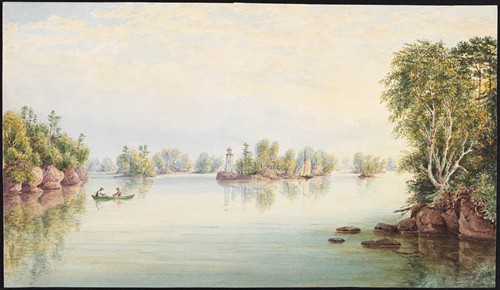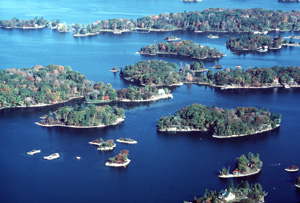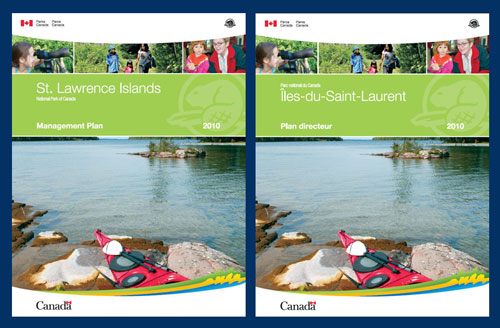Indigenous Partners
Growing Together: Partnering at St. Lawrence Islands
National Park (now Thousand Islands National Park) to Protect
Natural and Cultural Resources
This year Parks Canada is celebrating its centennial as the
world's first national parks service. Recognized as a
world leader in the conservation and presentation of this country's
cultural and natural heritage, Parks Canada offers world-class
experiences and educational opportunities for all. These
efforts are enriched by building meaningful partnerships, including
with Indigenous communities.
The Thousand Islands, once romantically referred to as the
"Garden of the Great Spirit," has been host to human activities and
natural phenomena for tens of thousands of years. Located
along the international border at the confluence of the St.
Lawrence River and Lake Ontario, this fascinating landscape is as
much a part of the people inhabiting this area as they are part of
the land. 
It is here that you will find Canada's fifth oldest National
Park: Thousand Islands National Park (formerly known as St.
Lawrence Islands National Park). Even before its
establishment in 1904, perceptions of the park's role were shaped
and defined by those who made use of its resources including First
Nations groups and local settlers. Thousand Islands' current
management plan expresses values relating both to its natural,
built and intangible heritage. This holistic approach to
conservation is the result of an inclusive range of voices,
including building closer relationship with the local First Nations
community.
Parks Canada, over recent years, has been developing positive
and constructive partnerships with Indigenous communities across
Canada. This new relationship is evident at Thousand Islands
National Park which has become a partner with local First Nations
to preserve the ecological integrity of the park. This
mutually beneficial relationship enhances Parks Canada's care of
the park for future Canadians to enjoy while at the same time
helping to strengthen and encourage First Nations culture and
identity associated with the land. 
To appreciate the Thousands Islands region is to recognize both
the forces of nature that have acted to shape the land and
acknowledge human activities and beliefs which have defined
it. Many First Nations groups, such as the Haudenosaunee and
Algonquian, have used the islands for camping and hunting and
gathering activities and they have never lost their spiritual
attachment to the land. The first Europeans were the French
who passed through the region in the early 1600s. As the
gateway to the Great Lakes and the heart of the continent, the
Thousand Islands became a heavily travelled maritime corridor for
explorers, the fur trade, and later for merchants engaged in the
forwarding of goods to and from the Great Lakes. But it was
only in the late 1700s that settlers, mostly United Empire
Loyalists fleeing the United States, began to establish communities
along the St. Lawrence River's north shore. 
By the end of the nineteenth century, the Thousand Islands
became a popular retreat for the wealthy who arrived by rail and
boats seeking to enjoy nature and escape the commotion of urban
life. Resorts and other forms of diversion were
established to accommodate the sudden influx of city
dwellers. In 1856, many of the thousands of islands were held
in trust by the Indian Department (later the Department of Indian
and Northern Affairs) for the Mississaugas of Alnwick who
continually pressured the federal government to dispose of the land
and transfer the proceeds to them. Efforts at selling the
islands were not successful, although some were sold privately
to individuals. The sale of islands, coupled with the
sudden influx of tourists, began to alarm local residents who felt
a strong attachment to and ownership of the islands which they too
used for leisure activities. As a result, these citizens
petitioned government authorities to reserve some space for use as
public parks.
Protection came in 1904 when the Canadian government officially
designated nine islands and a mainland parcel of land as a national
park. Soon after, plans were implemented to improve and add
visitor facilities, such as docks and picnic shelters, and caretakers were hired for each of the
island sites. The park gradually expanded its holdings and
now includes over 20 islands and a larger mainland component.
New perceptions of Thousand Islands National Park emerged in the
1960s. Whereas park management had been centred on the
recreational needs of locals and visitors, the focus shifted to the
unique environment of the region. Site staff now included
naturalists and scientists who preserved and interpreted to
visitors the natural wonders of the national park. The park's
first management plan was implemented at this time. It made
no mention of First Nations' connection to the land or of the
significance of the park's cultural resources.
caretakers were hired for each of the
island sites. The park gradually expanded its holdings and
now includes over 20 islands and a larger mainland component.
New perceptions of Thousand Islands National Park emerged in the
1960s. Whereas park management had been centred on the
recreational needs of locals and visitors, the focus shifted to the
unique environment of the region. Site staff now included
naturalists and scientists who preserved and interpreted to
visitors the natural wonders of the national park. The park's
first management plan was implemented at this time. It made
no mention of First Nations' connection to the land or of the
significance of the park's cultural resources.
By the 1980s and '90s a new attitude in Canada towards
ecological and heritage conservation had emerged. The park's
Chief Naturalist, Don Ross, documented the ecological resources of
the park and the history of the park's islands landscape. By
the 1990s, the Federal Heritage Buildings Review Committee
recommended heritage designation of 15 structures within the park
(learn about these structures on the Canadian Register of Historic
Places with the list provided below). As Canadian society
became more inclusive, Parks Canada initiated a dialogue in early
2000 between the park and local First Nations to facilitate greater
understanding and appreciation of each party's view of the
park. The relationship was formally recognized with a Smoky
Fire event held at the park on August 1-2, 2007 creating awareness
of First Nations' relationship with and cultural and traditional
use of land.
 Many Indigenous groups have a long
association with the St. Lawrence River and its shoreline, which
have sustained life with bountiful resources for generations.
In recent times, though, Indigenous communities in general have
faced external and internal pressures. Factors such as
demands from outside governments, cultural assimilation, as well as
the loss of their traditional economic base have added tensions
within communities already facing internal frictions.
Many Indigenous groups have a long
association with the St. Lawrence River and its shoreline, which
have sustained life with bountiful resources for generations.
In recent times, though, Indigenous communities in general have
faced external and internal pressures. Factors such as
demands from outside governments, cultural assimilation, as well as
the loss of their traditional economic base have added tensions
within communities already facing internal frictions.
Despite these difficulties, First Nations' efforts to maintain
their culture and identity attest to their perseverance in the face
of these pressures. Within this context, the relationship
between Thousand Islands National Park and the local First Nations
community has, and continues to play, a role in recognizing and
reinforcing the contributions of Indigenous Peoples in Canadian
society as well as helping to sustain the living heritage of
the community for future generations.
Parks Canada has not always upheld this model of
cooperation. Establishment of certain initial National Parks
had Indigenous populations relocated while other Indigenous groups
associated with the land in question were given no say in the
establishment of these natural preserves. As Canada
redefined its legal and constitutional relationship with Indigenous
Peoples in the 1970s, so too did Parks Canada. It initiated
policy and legislative changes to reflect a new acceptance of
Indigenous perspectives of and contributions to resource
conservation. Many Indigenous working groups have since been
established with Parks Canada to inform decisions affecting
National Parks, National Marine Conservation Areas and National
Historic Sites.
Thus far, the partnership developed at the park has produced
positive outcomes for both parties: St. Lawrence Islands'
newsletter, Pitch Pine Post, features articles by
Indigenous Elders; various park staff, including summer students,
have been recruited from the local community; a cultural
preservation summer camp for First Nations youth has been
implemented. Most importantly, the park profits from Elders'
traditional knowledge and responsible conservation of park
resources all the while offering visitors enhanced learning
opportunities and unique, world-class experiences of Canada's
natural and cultural heritage.
The year 2011 marks Parks Canada's centennial as the world's
first national parks service for the protection, enjoyment and
education of Canada's outstanding national heritage. The 2010
St. Lawrence Islands National Park Management Plan, guided by a
holistic approach to resource conservation and presentation, is an
exemplary model of respect and dedication Parks Canada strives to
achieve in working to find common ground with multiple stakeholders
on which to collaborate and grow for the benefit of all.